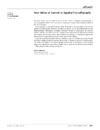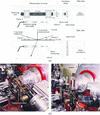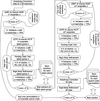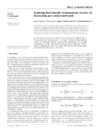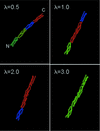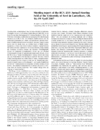issue contents
August 2007 issue

Cover illustration: Molecular electrostatic potential of thymidine mapped on the charge density isosurface at 0.5 e Å-3 using MolIso. Courtesy of C. B. Huebschle & P. Luger [J. Appl. Cryst. (2006), 39, 901-904].
editorial
Free 

research papers
A tensionometer for in situ powder diffraction studies of foils under stress has been constructed and used in a copper foil on beamline 2.3 of the Daresbury SRS. Both peak asymmetry and broadening were observed which was interpreted as being due to a cellular structure with cell walls and cell interiors possessing high and low dislocation densities.
A theoretical approach is developed to invert analytically a hard X-ray analyser-based phase-contrast image of a known weak object to recover the complex amplitude reflection coefficient of a locally homogeneous crystal.
Open  access
access
 access
accessA description is given of Phaser-2.1: software for phasing macromolecular crystal structures by molecular replacement and single-wavelength anomalous dispersion phasing.
A new procedure is proposed to determine sub-surface residual stress gradients by laboratory X-ray diffraction measurements at different depths using a chemical layer-removal technique. The standard correction algorithm for stress relaxation due to layer removal is improved by including corrections for X-ray absorption, and by the addition of constraints imposed by the mechanical equilibrium conditions.
A novel Raman/high-resolution X-ray powder diffraction setup has been designed for the investigation of solid-state transformations occurring in materials under in situ non-ambient conditions. The setup was tested by studying the kinetics of the fluorene–TCNQ synthesis, the thermal swelling and degradation of a stearate–hydrotalcite, and the photocycloaddition reaction of (E)-furylidenoxindole.
A functional relationship model approach is applied to the problem of calibration in a closed system. It accounts for all the variation due to sampling and measurement error in the peak intensities in quantitative X-ray diffraction analysis.
Download citation


Download citation


Increased instrumental intensity and resolution, and new effort in devising indexing algorithms, make it possible to detect, even from a biphasic mixture, the correct unit cell, and to solve (by direct methods or with direct-space algorithms) the crystal and molecular structure.
An improvement in the quality of Rietveld refinements with neutron time-of-flight data is possible by using a look-up table for the variation of peak positions and exponential profile function coefficients rather than using the empirical relations for these values.
Thin supported films of small aromatic molecules have been found to display a pronounced polymorphism. An effective scheme is described to find and index all thin-film reflections based on previously known molecular structures, thereby identifying reflections due to novel thin-film phases.
A general approach to model line broadening effects due to dislocations in powder diffraction patterns is proposed for materials of any symmetry.
The structure of the melt near the α-BaB2O4 crystal–melt interface was studied by high-temperature Raman spectroscopy. The growth units were determined and the crystal growth habit was predicted.
Download citation


Download citation


High-temperature neutron powder diffraction studies are performed to understand the origin of ferroelectricity in hexagonal multiferroic YMnO3 and YbMnO3.
The effect of an inhomogeneous fibre texture on the integrated intensity of a Bragg reflection is derived. The presented formalism allows for the determination of fibre texture gradients as they typically occur during the growth of thin polycrystalline films.
The EXPO2004 approach for determining the extinction symbol from powder diffraction data has been improved.
Download citation


Download citation


Two crystalline phases (cubic Pm m and trigonal P
m and trigonal P m1) have been found to coexist in both the BZN and BNN end members and mixed phases of Ba(Ni1/3Nb2/3)O3–Ba(Zn1/3Nb2/3)O3 (BNN–BZN).
m1) have been found to coexist in both the BZN and BNN end members and mixed phases of Ba(Ni1/3Nb2/3)O3–Ba(Zn1/3Nb2/3)O3 (BNN–BZN).
The real-space sample correlation function for a sphere is derived for kinematic and dynamic scattering.
Download citation


Download citation


Powder neutron refinements of two MgSO4 polymorphs are presented, and their highly anisotropic thermal expansivity is analysed using a Debye model.
short communications
This paper reconciles seeming contradictions between the authors' recent results on laterally heterogeneous vesicles and those of Knoll, Haas, Stuhrmann, Füldner, Vogel & Sackmann [J. Appl. Cryst. (1981), 14, 191–202].
computer programs
An internet computing engine has been developed to analyze three-dimensional protein molecules.
A flexible program that identifies domains on the basis of the crystal structure of multi-domain proteins is presented.
ORNL_SAS is software for calculating solution small-angle scattering intensity profiles from any structure provided in the Protein Data Bank format and can also compare the results with experimental data.
SUPERFLIP is a computer program for the solution of crystal structures from diffraction data. It works in arbitrary dimensions and is thus applicable not only to the solution of periodic structures, but also of incommensurately modulated structures and quasicrystals.
laboratory notes
A novel apparatus has been developed that enables the simultaneous determination of the absorption factor during measurement of small-angle X-ray scattering intensities of a sample.
A simple hermetic sample holder that fits the Philips X'Pert Pro X-ray diffractometer is described. It may be used to study the aging effects of uranium tritide during storage.
FOX, a single-crystal time-of-flight Laue diffractometer constructed at KENS in KEK for studies of structural and magnetic disorder and phase transitions, is described.
meeting reports
Free 

A report on the BCA 25th Annual Meeting held at the University of Kent in Canterbury, UK, 16–19 April 2007.


 journal menu
journal menu








